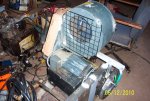kwired
Electron manager
- Location
- NE Nebraska
- Occupation
- EC
Might depend on what it is used for. As has been mentioned for centrifugal fans and pumps if it happens to slow down, the load demand from the fan/pump will decrease as well.I'm sure the essential questions are "How much circuit capacity needs to be provided?" and "What's the appropriate OCPD size?"
If the motor nameplate doesn't specify the full-load current at 200 volts, I'd base the motor-starter overload setting on the 230-volt full-load current, and specify at least 125% of that (60 amps) for the circuit ampacity.
If this is a new installation, (and maybe even if it's not -- Do the Math) I would return the 230-volt motor and install a 200-volt motor. This is a big enough consumer that its operating efficiency shouldn't be ignored.
Then when it comes to overall energy efficiency something that runs 24/7 at lesser efficiency cost more in energy losses than something that only gets occasional use. That occasional use could be a few minutes a day, couple hours but only once a month, or completely random and maybe sits for a year or more but runs for several hours when it is used.

